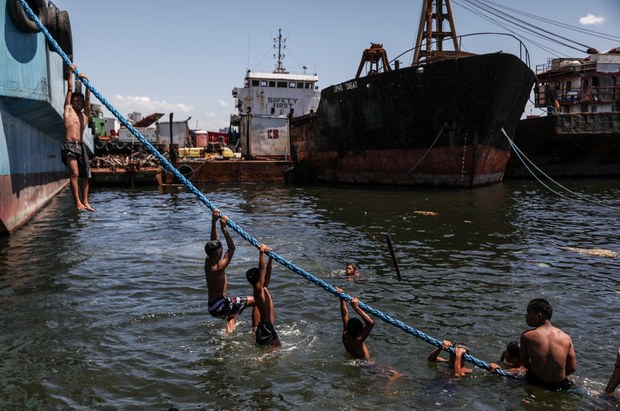Philippines Relaxes Pandemic Lockdown Rules in Capital Region
2021.11.05
Manila
 Filipino children living in shanties near Manila Bay use a rope to climb aboard a docked ship, which they use as a makeshift diving platform, March 31, 2021.
Filipino children living in shanties near Manila Bay use a rope to climb aboard a docked ship, which they use as a makeshift diving platform, March 31, 2021.
The Philippine government eased COVID-19 movement restrictions in the Metropolitan Manila region on Friday, allowing children to leave their homes and play outside after many months of being mostly cooped up during various pandemic lockdowns.
The Southeast Asian nation – particularly its national capital region, home to 14 million people – has been on different stages of lockdown during the past 20 months, one of the world’s longest.
During that time children have been home-schooled, which affects their mental and psychological well-being, according to child-rights advocates.
The loosening of the restrictions, upon the recommendation of health experts, means children can now go to parks and shopping malls, officials said. At the same time, physical classes in the tertiary level will also be open, subject to certain conditions, the government said.
The lowered alert system will last until Nov. 21 and be reassessed then, presidential spokesman Harry Roque told a press conference on Friday. The new rule extends across all of Metro Manila, which covers the city of Manila and at least 15 neighboring cities.
“The reason we’ve lowered it down to Alert Level 2 is that COVID cases have gone down, but anytime that can also go up knowing that we have more virulent variants. So, we still have to be careful,” Roque said.
“Limited face-to-face classes,” he said, would be allowed under the new alert level, subject to the Commission on Higher Education (CHED), the government agency in charge of tertiary education.
“First, teachers or faculty staff and the students must be fully vaccinated. Second, room capacity should be 50 percent,” he said, adding that the local governments should be in the know, and the educational facilities should be retrofitted for limited face-to-face classes, which would be inspected and authorized by CHED.
However, operations of casinos, racing-tracks, cock-fighting arenas, and other gaming establishments will remain closed, Roque said.
According to the new rule, those below 18 years of age are now permitted in public places. As soon as the order became official on Friday afternoon, young kids were seen with adults in malls across Manila.
All establishments are now allowed to operate at a maximum of 50 percent indoor capacity “for those that are fully vaccinated and those below 18, even if they are not vaccinated,” according to the new government guideline.
Seventy percent capacity is allowed for social gatherings and establishments if employees are fully vaccinated and wearing masks, the rules said.
These include birthday parties and wedding receptions, as well as museums, libraries, and amusement parks, Roque said. Other recreational and sporting venues, such as internet cafés, bowling alleys, swimming pools, are also covered.
At the press conference, Maria Rosario Vergeire, spokeswoman for the Philippine Department of Health, said that recorded new cases of COVID-19 had dropped from last week “to an average of 493 cases per day.”
The Philippines is among Southeast Asian countries hardest hit by the coronavirus, with almost 2.8 million infections and more than 44,000 deaths reported since the pandemic began here in March 2020.
The government, meanwhile, has ramped up vaccination efforts in recent weeks. Sixty-two million shots of the COVID-19 vaccine have been administered, according to the National COVID-19 Vaccination Dashboard, with 28.7 million people being fully vaccinated.
New rules will help tourism
The easing of restrictions is expected to provide greater mobility to the public and generate activities that could boost the economy, which has been in the doldrums throughout the pandemic.
“The eased travel restrictions under this alert level will greatly help tourism businesses bounce back and maximize the opportunities brought by the holiday season,” Tourism Secretary Berna Romulo-Puyat said in a statement.
“We also expect more Filipinos – especially families with children and elderly – to be able to enjoy our tourist destinations while following minimum health and safety protocols,” she added.
Child Rights Network, a group advocating for children’s rights, had earlier called on President Rodrigo Duterte to push for the gradual reopening of schools in areas considered low risk.
Schools in the Philippines have been closed since March 2020, and the Philippines is one of the only two countries that have yet to set a date for reopening schools – the other being Venezuela – the network said in September.
The number of schoolchildren enrolled has dropped this year, compared to previous figures, the group said.
“We cannot stress enough: the declining participation rate and quality of education brought about by school closures is a learning and child development catastrophe waiting to happen,” the group said in a statement.







